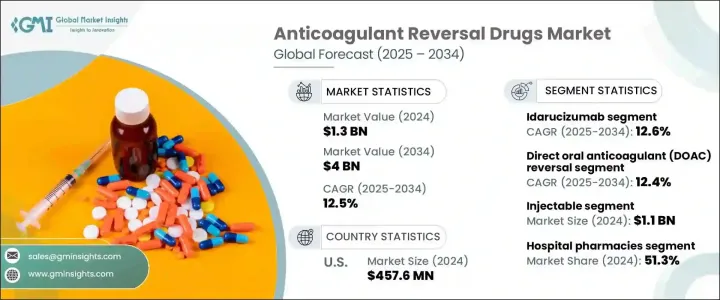PUBLISHER: Global Market Insights Inc. | PRODUCT CODE: 1684559

PUBLISHER: Global Market Insights Inc. | PRODUCT CODE: 1684559
Anticoagulant Reversal Drugs Market Opportunity, Growth Drivers, Industry Trend Analysis, and Forecast 2025 - 2034
The Global Anticoagulant Reversal Drugs Market, valued at USD 1.3 billion in 2024, is set to experience impressive growth, projected at a CAGR of 12.5% from 2025 to 2034. This market expansion is largely driven by the growing usage of anticoagulants and the rising incidence of bleeding complications, which emphasize the need for effective reversal agents. As cardiovascular diseases and thrombotic conditions like deep vein thrombosis, pulmonary embolism, and atrial fibrillation continue to increase, so does the demand for drugs that can quickly reverse anticoagulation effects in emergency situations. With the introduction of novel reversal agents for direct oral anticoagulants (DOACs), warfarin, and heparin, the landscape is transforming, making treatment more reliable and accessible for both patients and healthcare providers.

Aging populations worldwide, coupled with an increasing prevalence of chronic conditions, have significantly amplified the use of anticoagulants. Long-term anticoagulation therapy is now a common treatment for a variety of cardiovascular and thrombotic diseases. However, these treatments increase the risk of bleeding complications, creating a critical need for reliable reversal options. Anticoagulant reversal drugs address this challenge, ensuring patient safety during adverse events like severe bleeding or surgeries. As advancements in medical technology drive the development of more effective and rapid reversal therapies, the market is poised for further growth, benefiting from the wider adoption of these treatments in both clinical and hospital settings.
| Market Scope | |
|---|---|
| Start Year | 2024 |
| Forecast Year | 2025-2034 |
| Start Value | $1.3 Billion |
| Forecast Value | $4 Billion |
| CAGR | 12.5% |
The market is segmented by product type, which includes andexanet alfa, phytonadione (vitamin K), prothrombin complex concentrates, idarucizumab, protamine, and other related products. Idarucizumab, valued at USD 443.5 million in 2024, is anticipated to experience a CAGR of 12.6% during the forecast period, driven by its role in reversing the effects of dabigatran. Dabigatran is a widely used DOAC, particularly for managing conditions such as atrial fibrillation and deep venous thrombosis.
When it comes to the route of administration, the market is split into injectable and oral forms. The injectable segment leads the market, valued at USD 1.1 billion in 2024, as injectables are preferred in critical situations for their quick and effective action. These fast-acting drugs are essential for reversing anticoagulation during emergencies like severe bleeding or urgent surgeries, where immediate intervention is crucial.
In the U.S., the anticoagulant reversal drugs market was valued at USD 457.6 million in 2024. The increasing incidence of chronic conditions requiring anticoagulation therapy, such as cardiovascular and kidney diseases, has driven the demand for both anticoagulants and their reversal agents. Furthermore, regulatory support that encourages the development of safer anticoagulants and reversal therapies further boosts the U.S. market, which is experiencing continued growth. With a large and growing elderly population at risk for thromboembolic and bleeding disorders, the U.S. market is expected to see sustained demand as new reversal drugs and therapies are introduced and incorporated into clinical practices.
Table of Contents
Chapter 1 Methodology and Scope
- 1.1 Market scope and definition
- 1.2 Research design
- 1.2.1 Research approach
- 1.2.2 Data collection methods
- 1.3 Base estimates and calculations
- 1.3.1 Base year calculation
- 1.3.2 Key trends for market estimation
- 1.4 Forecast model
- 1.5 Primary research and validation
- 1.5.1 Primary sources
- 1.5.2 Data mining sources
Chapter 2 Executive Summary
- 2.1 Industry 3600 synopsis
Chapter 3 Industry Insights
- 3.1 Industry ecosystem analysis
- 3.2 Industry impact forces
- 3.2.1 Growth drivers
- 3.2.1.1 Growing aging population
- 3.2.1.2 Rising prevalence of conditions requiring anticoagulation therapy
- 3.2.1.3 Emergence of new anticoagulants
- 3.2.2 Industry pitfalls and challenges
- 3.2.2.1 Side effects associated with these drugs
- 3.2.1 Growth drivers
- 3.3 Growth potential analysis
- 3.4 Regulatory landscape
- 3.5 Pipeline analysis
- 3.6 Porter's analysis
- 3.7 PESTEL analysis
Chapter 4 Competitive Landscape, 2024
- 4.1 Introduction
- 4.2 Company matrix analysis
- 4.3 Competitive analysis of major market players
- 4.4 Competitive positioning matrix
- 4.5 Strategy dashboard
Chapter 5 Market Estimates and Forecast, By Product, 2021 – 2034 ($ Mn)
- 5.1 Key trends
- 5.2 Idarucizumab
- 5.3 Phytonadione (Vitamin K)
- 5.4 Prothrombin complex concentrates
- 5.5 Andexanet alfa
- 5.6 Protamine
- 5.7 Other products
Chapter 6 Market Estimates and Forecast, By Application, 2021 – 2034 ($ Mn)
- 6.1 Key trends
- 6.2 Direct oral anticoagulant (DOAC) reversal
- 6.3 Warfarin reversal
- 6.4 Heparin and low-molecular-weight heparin (LMWH) reversal
- 6.5 Other applications
Chapter 7 Market Estimates and Forecast, By Route of Administration, 2021 – 2034 ($ Mn)
- 7.1 Key trends
- 7.2 Injectable
- 7.3 Oral
Chapter 8 Market Estimates and Forecast, By Distribution Channel, 2021 – 2034 ($ Mn)
- 8.1 Key trends
- 8.2 Hospital pharmacies
- 8.3 Retail pharmacies
- 8.4 Online pharmacies
Chapter 9 Market Estimates and Forecast, By Region, 2021 – 2034 ($ Mn)
- 9.1 Key trends
- 9.2 North America
- 9.2.1 U.S.
- 9.2.2 Canada
- 9.3 Europe
- 9.3.1 Germany
- 9.3.2 UK
- 9.3.3 France
- 9.3.4 Italy
- 9.3.5 Spain
- 9.3.6 Netherlands
- 9.4 Asia Pacific
- 9.4.1 China
- 9.4.2 Japan
- 9.4.3 India
- 9.4.4 Australia
- 9.4.5 South Korea
- 9.5 Latin America
- 9.5.1 Brazil
- 9.5.2 Mexico
- 9.5.3 Argentina
- 9.6 Middle East and Africa
- 9.6.1 South Africa
- 9.6.2 Saudi Arabia
- 9.6.3 UAE
Chapter 10 Company Profiles
- 10.1 Amneal Pharmaceuticals
- 10.2 AstraZeneca
- 10.3 Cipla
- 10.4 CSL Behring Limited
- 10.5 Dr. Reddy’s Laboratories
- 10.6 Endo International
- 10.7 Lupin
- 10.8 Mylan N.V.
- 10.9 Novartis
- 10.10 Pfizer
- 10.11 Sun Pharmaceutical Industries
- 10.12 Teva Pharmaceutical Industries




